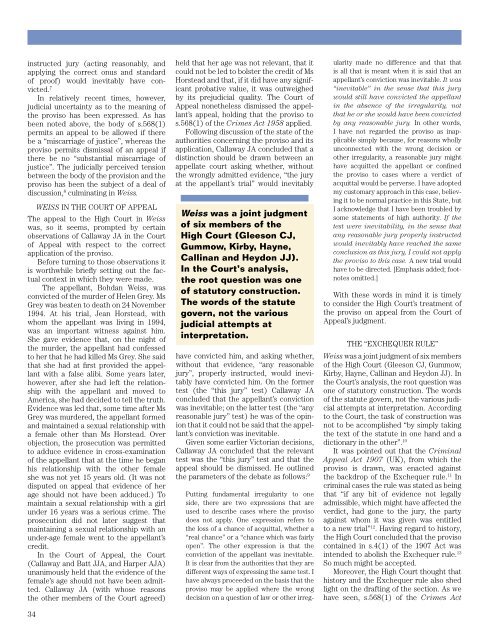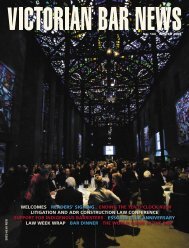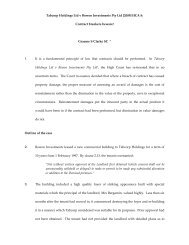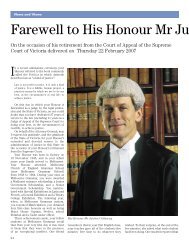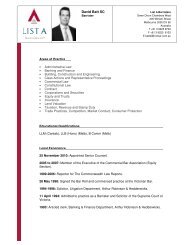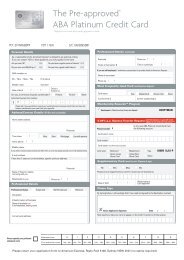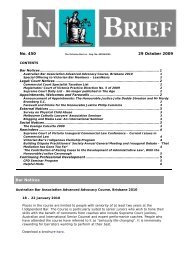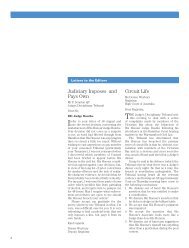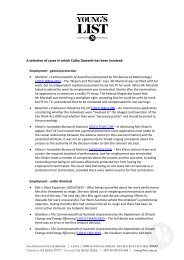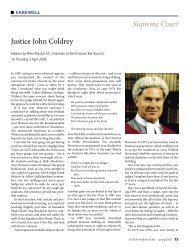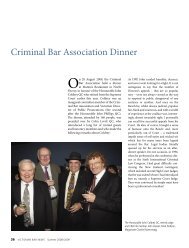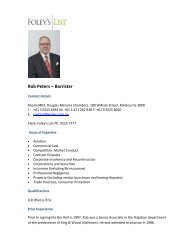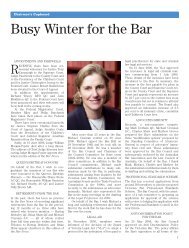Justice William Charles Crockett AO - Victorian Bar
Justice William Charles Crockett AO - Victorian Bar
Justice William Charles Crockett AO - Victorian Bar
- No tags were found...
You also want an ePaper? Increase the reach of your titles
YUMPU automatically turns print PDFs into web optimized ePapers that Google loves.
instructed jury (acting reasonably, andapplying the correct onus and standardof proof) would inevitably have convicted.7In relatively recent times, however,judicial uncertainty as to the meaning ofthe proviso has been expressed. As hasbeen noted above, the body of s.568(1)permits an appeal to be allowed if therebe a “miscarriage of justice”, whereas theproviso permits dismissal of an appeal ifthere be no “substantial miscarriage ofjustice”. The judicially perceived tensionbetween the body of the provision and theproviso has been the subject of a deal ofdiscussion, 8 culminating in Weiss.34WEISS IN THE COURT OF APPEALThe appeal to the High Court in Weisswas, so it seems, prompted by certainobservations of Callaway JA in the Courtof Appeal with respect to the correctapplication of the proviso.Before turning to those observations itis worthwhile briefly setting out the factualcontext in which they were made.The appellant, Bohdan Weiss, wasconvicted of the murder of Helen Grey. MsGrey was beaten to death on 24 November1994. At his trial, Jean Horstead, withwhom the appellant was living in 1994,was an important witness against him.She gave evidence that, on the night ofthe murder, the appellant had confessedto her that he had killed Ms Grey. She saidthat she had at first provided the appellantwith a false alibi. Some years later,however, after she had left the relationshipwith the appellant and moved toAmerica, she had decided to tell the truth.Evidence was led that, some time after MsGrey was murdered, the appellant formedand maintained a sexual relationship witha female other than Ms Horstead. Overobjection, the prosecution was permittedto adduce evidence in cross-examinationof the appellant that at the time he beganhis relationship with the other femaleshe was not yet 15 years old. (It was notdisputed on appeal that evidence of herage should not have been adduced.) Tomaintain a sexual relationship with a girlunder 16 years was a serious crime. Theprosecution did not later suggest thatmaintaining a sexual relationship with anunder-age female went to the appellant’scredit.In the Court of Appeal, the Court(Callaway and Batt JJA, and Harper AJA)unanimously held that the evidence of thefemale’s age should not have been admitted.Callaway JA (with whose reasonsthe other members of the Court agreed)held that her age was not relevant, that itcould not be led to bolster the credit of MsHorstead and that, if it did have any significantprobative value, it was outweighedby its prejudicial quality. The Court ofAppeal nonetheless dismissed the appellant’sappeal, holding that the proviso tos.568(1) of the Crimes Act 1958 applied.Following discussion of the state of theauthorities concerning the proviso and itsapplication, Callaway JA concluded that adistinction should be drawn between anappellate court asking whether, withoutthe wrongly admitted evidence, “the juryat the appellant’s trial” would inevitablyWeiss was a joint judgmentof six members of theHigh Court (Gleeson CJ,Gummow, Kirby, Hayne,Callinan and Heydon JJ).In the Court’s analysis,the root question was oneof statutory construction.The words of the statutegovern, not the variousjudicial attempts atinterpretation.have convicted him, and asking whether,without that evidence, “any reasonablejury”, properly instructed, would inevitablyhave convicted him. On the formertest (the “this jury” test) Callaway JAconcluded that the appellant’s convictionwas inevitable; on the latter test (the “anyreasonable jury” test) he was of the opinionthat it could not be said that the appellant’sconviction was inevitable.Given some earlier <strong>Victorian</strong> decisions,Callaway JA concluded that the relevanttest was the “this jury” test and that theappeal should be dismissed. He outlinedthe parameters of the debate as follows: 9Putting fundamental irregularity to oneside, there are two expressions that areused to describe cases where the provisodoes not apply. One expression refers tothe loss of a chance of acquittal, whether a“real chance” or a “chance which was fairlyopen”. The other expression is that theconviction of the appellant was inevitable.It is clear from the authorities that they aredifferent ways of expressing the same test. Ihave always proceeded on the basis that theproviso may be applied where the wrongdecision on a question of law or other irreg-ularity made no difference and that thatis all that is meant when it is said that anappellant’s conviction was inevitable. It was“inevitable” in the sense that this jurywould still have convicted the appellantin the absence of the irregularity, notthat he or she would have been convictedby any reasonable jury. In other words,I have not regarded the proviso as inapplicablesimply because, for reasons whollyunconnected with the wrong decision orother irregularity, a reasonable jury mighthave acquitted the appellant or confinedthe proviso to cases where a verdict ofacquittal would be perverse. I have adoptedmy customary approach in this case, believingit to be normal practice in this State, butI acknowledge that I have been troubled bysome statements of high authority. If thetest were inevitability, in the sense thatany reasonable jury properly instructedwould inevitably have reached the sameconclusion as this jury, I could not applythe proviso to this case. A new trial wouldhave to be directed. [Emphasis added; footnotesomitted.]With these words in mind it is timelyto consider the High Court’s treatment ofthe proviso on appeal from the Court ofAppeal’s judgment.THE “EXCHEQUER RULE”Weiss was a joint judgment of six membersof the High Court (Gleeson CJ, Gummow,Kirby, Hayne, Callinan and Heydon JJ). Inthe Court’s analysis, the root question wasone of statutory construction. The wordsof the statute govern, not the various judicialattempts at interpretation. Accordingto the Court, the task of construction wasnot to be accomplished “by simply takingthe text of the statute in one hand and adictionary in the other”. 10It was pointed out that the CriminalAppeal Act 1907 (UK), from which theproviso is drawn, was enacted againstthe backdrop of the Exchequer rule. 11 Incriminal cases the rule was stated as beingthat “if any bit of evidence not legallyadmissible, which might have affected theverdict, had gone to the jury, the partyagainst whom it was given was entitledto a new trial” 12 . Having regard to history,the High Court concluded that the provisocontained in s.4(1) of the 1907 Act wasintended to abolish the Exchequer rule. 13So much might be accepted.Moreover, the High Court thought thathistory and the Exchequer rule also shedlight on the drafting of the section. As wehave seen, s.568(1) of the Crimes Act


